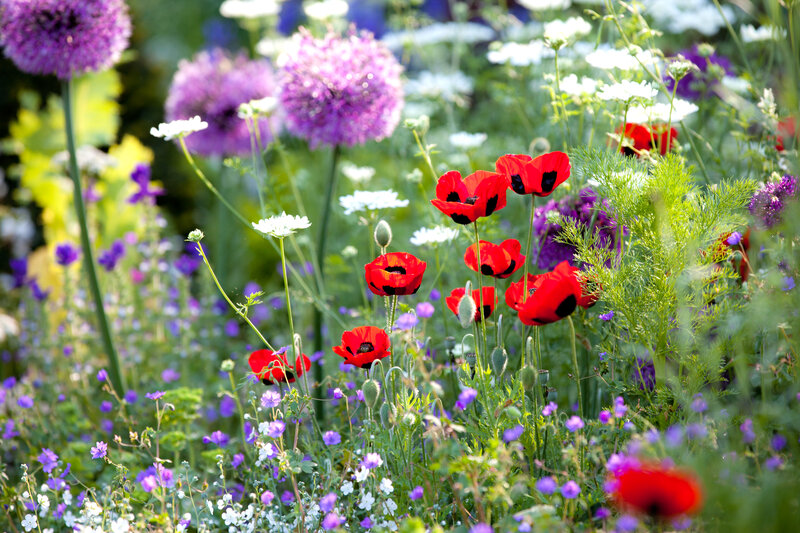CA Contractors #344056

One of the best ways to enjoy year-round color, texture, and interest - both inside and outside the home - is to design a cutting garden. A cutting garden uses raised beds or gopher-resistant ground options to grow your own gorgeous flower garden.
In the landscape design world, we call this a “cutting garden,” which is to the eyes and soul what kitchen gardens are to the home cook’s palate and stomach.
If you love the look of fresh-cut, seasonal flowers around your home or office, designing a cutting garden is a beautiful and affordable way to go about it.
Best of all, for those who love the looks of fresh flowers, but don’t necessarily have a green thumb or the time to grow them, your cutting garden can be easily maintained by your landscape professionals, ensuring you can go cut some of your favorite blooms whenever you want them.
Here are tips on how to design a year-round cutting garden:
If you are newer to the art of flower arrangement, we recommend visiting BHG’s post, 8 Simple Steps to Arrange Flowers Like a Pro. If you find your interest in flower arrangements grows along with your backyard cutting garden, there are fantastic books available at your local bookstore (or library).
You might also want to take a class in flower arranging. These are often available through community education programs at local JCs or you can find them online.
When it comes to flower arranging, long-stemmed varieties work best. Cutting extra length from the garden gives you wiggle room as you trim leaves from the stems and gives you room to work with as you adjust stem heights to arrange blooms in vases or other containers.
Did you know many plants depend on your cuts to help them flourish? Most cutting garden flowers are annuals, so regular cuttings are required to keep summer/fall plants blooming through the first frost.
To keep cutting as ergonomically comfortable as possible from edge to middle, we recommend keeping your flower beds or rows no more than 2.5- to 3-feet wide. To accommodate the number of plants required to grow enough blooms for weekly bouquets, it’s nice to keep rows between 20- and 30-feet long.
Longer flower bed lengths make it a pleasure to walk between rows, surrounding yourself with the beautiful sight of the flowers, the multiple fragrances that abound, and to enjoy the satisfying hum of pollinators' wings as they delight in the abundance you’ve provided for them. In fact, designing a garden that attracts pollinators is a way to benefit from gorgeous blooms and an eco-friendly landscape design.
The denser you plant your flowers, the less you have to worry about weeds. Once the flowers have filled in all the space, they don’t leave room for weeds, so it’s a win-win for both the flowers and their dedicated gardeners.
The more you get into cutting flowers for DIY bouquets, the more your awareness of flower varieties will expand. We find starting flowers from seeds is the best way to grow flowers that don’t seem to make their way into the typical nursery or garden supply store. Read, Growing Annual Flowers From Seed, to learn more on how to do that successfully.
What are your favorite colors, and which colors do you enjoy seeing together? Taking a list of your favorite colors will help garden professionals select the best long-stemmed and multi-dimensional flowers for your garden.
If you aren’t used to thinking about what colors go together, we recommend reading BHG’s article on How to Use the Color Wheel. Typically used for interior design, the same principles hold true for garden design and flower arranging.
Professional florists and floral arrangers keep a diverse array of flowers in their cool storage because they know how important variety is to visual satisfaction. Yes, in the spring, there may be nothing more cheerful than a bouquet that consists only of fresh-cut daffodils or tulips.
However, most of the time, flower arrangements are designed with flowers of multiple shapes and sizes (and don’t forget texture!) for more visual interest. Cutting gardens should be designed with lots of forethought - taking these factors into consideration:
Most bouquets also include some type of greenery filler for contrast and shaping. Many of these grow well in border beds or containers if you don’t want to mix them into your flower beds. All are a nice addition to areas of the garden dedicated to a green-only aesthetic, which can be soothing and refreshing spaces to sit and rest.
Examples of these plants include:
Here in the Bay Area, we enjoy more water than the majority of the central and southern parts of the state. Even so, the most sustainable landscapes take water conservation into the picture. The good news is there is a variety of drought-tolerant plants that produce attractive blooms such as coneflower, hyssop, marigold, nasturtium, and sea lavender.
Other flowering plants that require less water are Mexican hat, native rose, coreopsis, cosmos, and zinnia.
Would you like support designing or maintaining your annual cutting garden? Contact Bay Area Landscapes and schedule a consultation. We help to grow and maintain cutting gardens for home and business owners throughout the Bay Area.